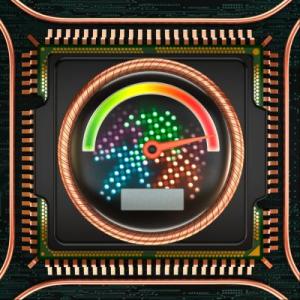Nov 5 2013
A new international research collaboration announced today will deliver highly accurate measurements of strain in materials at the nano-scale to drive innovation in next generation electronic devices. The European Metrology Research Programme's Nanostrain project brings together public institutions from across Europe supported by global industry leaders including IBM.
A particular focus for the consortium is a class of materials (piezoelectrics) that change their shape in response to electric voltages. The project aims to advance commercial opportunities arising from controlled strain in nano-scale piezoelectrics including the development of the first Piezoelectric-Effect-Transistor (PET), a new digital switch with the potential to offer increased speed, reduced micro-chip size and lower power consumption.
 This is an artistic image representing the effort to push the limits of current cpu technology to faster and better performances and at the same time. Credit: Nanostrain project
This is an artistic image representing the effort to push the limits of current cpu technology to faster and better performances and at the same time. Credit: Nanostrain project
Advances here would overcome a decade of stagnation in semiconductor transistor performance which has seen computational processing power fail to increase by more than a few percent since 2003.
However progress in these areas is dependent on the development of new and more accurate measurements and best practise to better understand strain at the nano-scale and how it can be exploited.
To address this 'final piece of the jigsaw' the European Metrology Research Programme's three year Nanostrain project brings together several European national laboratories along with a consortium of collaborators including world class research instrument facilities at the ESRF and nine commercial companies spanning a wide range of applications.
The project will develop new tools for the characterisation of nano-strain under industrially relevant conditions of high stress, and electric fields. The results will then be openly available to manufacturers and designers to encourage innovation across a wide range of industries.
Prof Markys Cain, Nanostrain project lead at NPL said: "This is a completely unique collaboration, unparalleled in terms of its collective expertise in the areas of material science, metrology and the properties and performance of piezoelectric systems. It's an exciting project to be involved in as it won't be simply going over old ground or providing a minor improvement on what already exists. Currently there is no metrological framework or facilities for traceable measurement in this area. This is high risk, challenging work that will underpin a major step change in the performance of devices we use every day and bring highly influential new technologies to market in diverse sectors such as microelectronics, ICT, 3D printing and sensors industries."
Dr. Burkhard Beckhoff at PTB said: "Europe is particularly well positioned to benefit from new electronic components such as transistors and memory devices based on nanoscale functional materials, with a strong technology-driven manufacturing sector and a vibrant community of innovative companies. Through Nanostrain we hope to establish the metrological and material science foundations in Europe from which our ICT, bio-medical, sensors and instrumentation sectors can innovate and lead the world in the future."
Dr Glenn J. Martyna at IBM said: "Computer clock speeds have remained frozen since 2003, limiting not only innovation in new electronics, but also in global efforts to improve energy efficiency and reduce power consumption within the electronics sector as a whole. However with our latest calculations suggesting piezoelectronic transistors can operate at one-tenth of the voltage of today's CMOS equivalent, consuming 100 times less power as they do so, we believe we are on the verge of a major breakthrough. The next steps include improving our understanding of how this technology could best work in practise, and that relies on a better understanding of how these nano-scale piezoelectric materials strain in order to optimise their commercial performance. We are excited to be part of the EMRP Nanostrain project because we believe this impressive collection of organisations and expertise can deliver this important final step towards long-awaited fast processing speeds."
Press release avilable from http://www.eurekalert.org/